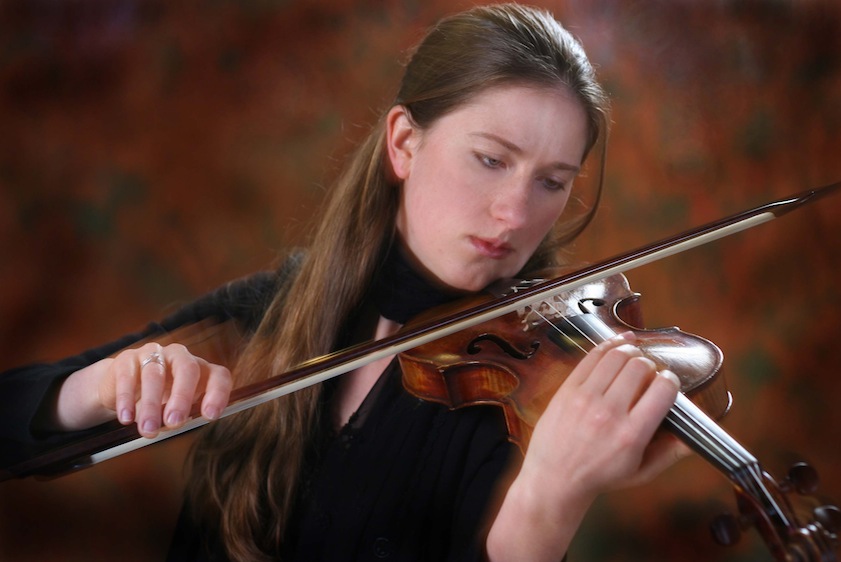Boston Baroque presents the spiritual bravura of Biber’s “Mystery” sonatas

Christina Day Martinson performed BIber's "Mystery" sonatas Sunday afternoon with Boston Baroque.
If Paganini kept the devil on his shoulder, Biber kept his Lord close by. Both inspirations worked. Proving it, in a flourish of technical complexity and musical wizardry, violinist Christina Day Martinson and her Boston Baroque counterparts presented a first installment of Biber’s Mystery sonatas Sunday afternoon at First Church in Cambridge.
The Mystery (or Rosary) sonatas are the finest examples of Biber’s exploration of scordatura, alternate tunings of the violin strings that present otherworldly sonic textures and tremendous performance challenges. Biber was not the only composer to tinker with tunings, but certainly its most efficient and adventurous practitioner.
These sixteen sonatas, of which Martinson played about half, demand a different string configuration for each, requiring Martinson to use not only four different violins but a technician to prepare them as well. The sonatas are the musical imaginings of a worshipper saying the rosary: divided into three groups, or mysteries, in turns Joyful, Sorrowful, and Glorious, with a coda. Martinson played most of the first two sets, with a second program planned for next season.
Biber creates the sonatas with parts of what Bach would call suites: some have a prelude, aria and gigue; some, and aria and variations; others, a chaconne, allemande or courante.
The tunings change the violinist’s universe. Instead of reading notes in the score that correspond to pitches, the violinist uses the score for fingerings only, with the pitches being played not matching what is printed on the page. “The score becomes a kind of tablature,” Martinson said from the stage. Every musician spends countless hours preparing for each minute of performance; one can only imagine Martinson’s preparation for this program.
She played Baroque instruments, with appropriate techniques, mostly notably a greatly restrained use of vibrato. Fingering these sonatas was tricky enough, but it is in the bowing that Biber demands the greatest virtuosity. Martelé and tremolo passages were the rule, not the exception. Of the opening Joyful Mysteries set, which details Jesus’ birth and youth, once Martinson warmed up, the music came to life. Sonata IV, The Presentation in the Temple, is a chaconne and variations, tuned to D minor. With the bottom string up a step and the top string down one, a mellow, almost viola-like quality is produced. That, contrasted with the blazing virtuosity required in most of the variations, created a disconnect between the eyes and ears: instead of soprano passages, Martinson delivered alto brilliance. The execution was breathtaking, and only a hint of what followed.
Sonata VI, with the top string tuned down to C#, offered more dark textures (a long Lamento, to begin the Sorrowful Mysteries, depicting the Agony in the Garden). Sonata VIII, tuned to a Bb chord so that the violin cannot extend below D, offered the opposite sound-world for the Crowning of the Thorns. At the climax of this set, Sonata X, an aria and variations in G minor depicting the Crucifixion, Martinson let loose like a racer sensing the finish line, nearly outpacing her accompaniment with bravura tremolo passages.
These sonatas are far too technically complex to find a home in the standard Baroque repertory, which made Martinson’s artistry and accomplishment even more pronounced. She was ably supported by continuo players Martin Pearlman (Boston Baroque’s music director) on organ or harpsichord), Sarah Freiberg (cello) and Victor Coelho (theorbo).
Posted in Performances





Posted Feb 13, 2012 at 9:18 pm by Gail Ryan
Woweewow! Congratulations Christina! Oh how I wish I was there. Please keep me in the future notifications. Can’t wait to hear Biber in person.